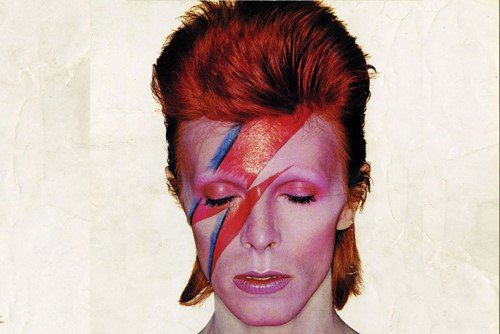The world mourns with the unexpected passing of David Bowie following his eighteen-month battle with cancer, and the release of his final album ‘Blackstar’ on January 8.
In hindsight, his battle with cancer and impending passing is referenced in farewell song, ‘Lazarus’, with what has been reported as a well coordinated operation for his final gift to the world.

“Look up here, I’m in heaven
I’ve got scars that can’t be seen”
“This way or no way
You know, I’ll be free”
This all comes on the heels of Sydney Festival’s announcement to host a free David Bowie Tribute for 6.15pm, Wednesday January 13 from Meriton Festival Village, Hyde Park where fans are encouraged to don their best Ziggy Stardust threads and pay homage to a cultural icon. Indeed, the Brixton artist was many things to billions of people worldwide.
His iconic looks began with anisocoria – when one pupil permanently dilates for it to look much bigger than the other – leaving him with his infamous mismatched eyes; an incident when he was punched in the face by childhood friend George Underwood over an argument about a girl. David Bowie was much more than a multi-instrumentalist. He was more than a musician and a producer. He overstepped being an actor.
He eclipsed musical genres, created fashions and trends to transcend beyond humanity and even the earth. He united East and West Berlin in 1987 along with Genesis and The Eurythmics for a three-day concert that would cause ripples, leading to the momentous fall of the Berlin Wall. He challenged society’s views on sexuality as an androgynous bixsexual alien, paving the way for the LGBT movement and becoming the world’s first gay icon. He would also bring glamour to interracial relationships with his marriage to Somali-born supermodel Iman in 1992. He was even politically risqué where his track ‘Let’s Dance’ placed the affairs of Indigenous Australia under the world spotlight by referencing domestic slavery and assimilation. The making of the clip would be captured in the 2015 documentary LET’S DANCE: BOWIE DOWN UNDER.
David Bowie bent the rules on everything, from his sex life to exploring the world of drugs. He might have emerged as the poster child of illicits during the 1970s but this allowed him to expand his mind and produce many colourful characters – for he was an artist with many names: The humble David Jones evolved into Davy/ Davie Jones, Space Oddity, Starman, The Elephant Man, Aladdin Sane, Ziggy Stardust, The Thin White Duke, The Man Who Fell To Earth, Major Celliers, Pontius Pilate, Nikola Tesla and Goblin King Jareth from Labyrinth.

The one thing David Bowie never was: He wasn’t a rock star
“Well I’m not a rock star you see. You’ve just said it. I’m not in rock n roll.” John Lennon would refute this though, commenting that David’s work was rock n roll – just with lipstick on.
David Bowie was undoubtedly intelligent – bantering with journalists and frequently beating them at their own game in witty wars of words. He traversed through music, poetry, fashion, performing arts, acting, producing, visual arts, multi-media, technology, politics dance and theatre with genuine fluidity as the ultimate popular cultural icon. He would inspire a legion of popstars from Boy George to Annie Lennox, Prince, Marilyn Manson, Madonna, Lady Gaga, Kurt Cobain – and more

He was a singer-songwriter, saxophonist and guitarist who manoeuvred through the genres of glam rock, art rock, hard rock, dance pop, punk, blue eyed soul, electronica and free jazz; all during a multifarious 40-year career. His cut-up writing technique of creating the lyrics to his songs – a Dada technique that took lines of text, cutting the words into pieces then rearranging – was legendary, adding an element of chance to his entire creative process.

He would write songs and play with the who’s-who of music, from Cher to John Lennon, Nile Rogers, Tina Turner, Iggy Pop, Brian Eno, Moby and Queen, amongst many others.
He was truly utopian, taking his bandmates to the ballet to learn about stage lighting, allowing ‘Space Oddity’ to be used for the 1969 landing of Apollo 11 and setting up his own internet service provider with BowieNet in 1998. As a visionary, he would keep a step ahead of everyone and everything. In his 2002 interview with Jon Pareles from the New York Times here, he foresees the future of music by recognising record labels, distribution and copyright would become defunct, while prophesising the coming of streaming and iTunes.
He was continually reinventing himself over and over again. Out of all his many names and reinventions however, he emerged as one singular figure: the voice for all dissident oddballs; the lone wolf leading the pack of quirky nutters. David Bowie was his own piece of art. Even his death would be perfectly orchestrated. For all the characters we knew him as, we never actually knew him as David Jones the man. He would leave this message to his artistry.
‘Space Oddity’ (1969)

‘Changes’ (1971)

Young Americans Live (1974)

covering The Pixie’s ‘Cactus’ with Moby, live on the Jay Leno Show (2002)

‘Blackstar’ (2015)

The world mourns at the light that has gone out. David Bowie leaves an immense legacy of how brightly his light burned and the warmth he gave us through his art. One thing for sure, he is now in heaven with Freddie having a hell of a sing-along.




